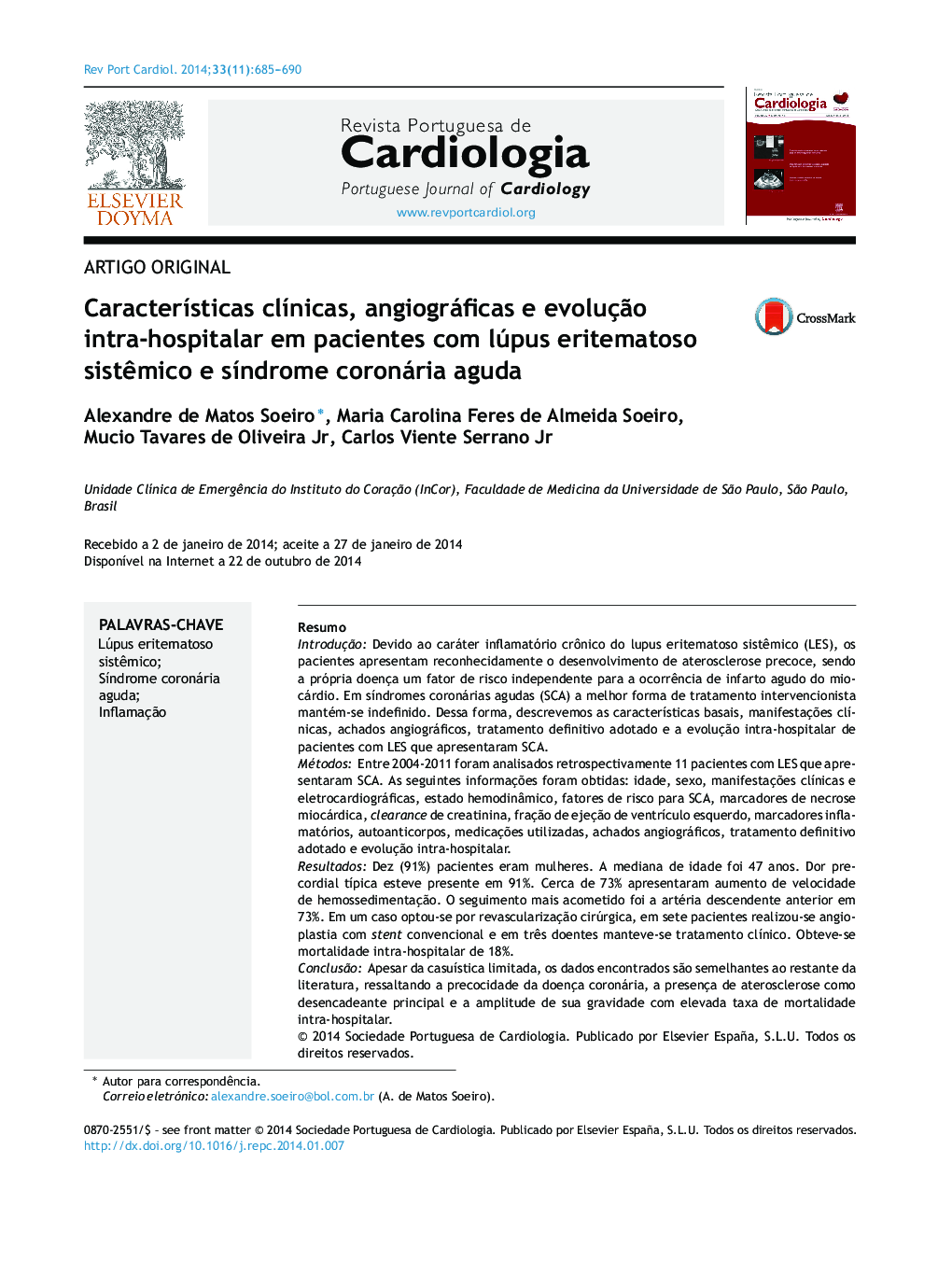| Article ID | Journal | Published Year | Pages | File Type |
|---|---|---|---|---|
| 1126008 | Revista Portuguesa de Cardiologia | 2014 | 6 Pages |
ResumoIntroduçãoDevido ao caráter inflamatório crônico do lupus eritematoso sistêmico (LES), os pacientes apresentam reconhecidamente o desenvolvimento de aterosclerose precoce, sendo a própria doença um fator de risco independente para a ocorrência de infarto agudo do miocárdio. Em síndromes coronárias agudas (SCA) a melhor forma de tratamento intervencionista mantém‐se indefinido. Dessa forma, descrevemos as características basais, manifestações clínicas, achados angiográficos, tratamento definitivo adotado e a evolução intra‐hospitalar de pacientes com LES que apresentaram SCA.MétodosEntre 2004‐2011 foram analisados retrospectivamente 11 pacientes com LES que apresentaram SCA. As seguintes informações foram obtidas: idade, sexo, manifestações clínicas e eletrocardiográficas, estado hemodinâmico, fatores de risco para SCA, marcadores de necrose miocárdica, clearance de creatinina, fração de ejeção de ventrículo esquerdo, marcadores inflamatórios, autoanticorpos, medicações utilizadas, achados angiográficos, tratamento definitivo adotado e evolução intra‐hospitalar.ResultadosDez (91%) pacientes eram mulheres. A mediana de idade foi 47 anos. Dor precordial típica esteve presente em 91%. Cerca de 73% apresentaram aumento de velocidade de hemossedimentação. O seguimento mais acometido foi a artéria descendente anterior em 73%. Em um caso optou‐se por revascularização cirúrgica, em sete pacientes realizou‐se angioplastia com stent convencional e em três doentes manteve‐se tratamento clínico. Obteve‐se mortalidade intra‐hospitalar de 18%.ConclusãoApesar da casuística limitada, os dados encontrados são semelhantes ao restante da literatura, ressaltando a precocidade da doença coronária, a presença de aterosclerose como desencadeante principal e a amplitude de sua gravidade com elevada taxa de mortalidade intra‐hospitalar.
ObjectiveDue to the chronic inflammation associated with systemic lupus erythematosus (SLE), patients develop premature atherosclerosis and the disease is a risk factor for acute myocardial infarction. The best interventional treatment for acute coronary syndrome (ACS) in these patients is unclear. The objective of this study is to describe the baseline characteristics, clinical manifestations, treatment and in‐hospital outcome of patients with SLE and ACS.MethodsEleven SLE patients with ACS were analyzed retrospectively between 2004 and 2011. The following data were obtained: age, gender, clinical and electrocardiographic characteristics, Killip class, risk factors for ACS, myocardial necrosis markers (CK‐MB and troponin), creatinine clearance, left ventricular ejection fraction, inflammatory markers (C‐reactive protein and erythrocyte sedimentation rate), drugs used during hospital stay, treatment (medical, percutaneous or surgical) and in‐hospital outcome. The statistical analysis is presented in percentages and absolute values.ResultsTen of the patients (91%) were women. The median age was 47 years. Typical precordial pain was present in 91%. Around 73% had positive erythrocyte sedimentation rate. The vessel most often affected was the anterior descending artery, in 73%. One patient underwent coronary artery bypass grafting, seven underwent percutaneous coronary intervention with bare‐metal stents and three were treated medically. In‐hospital mortality was 18%.ConclusionsDespite the small number of patients, our findings were similar to those in the literature, showing coronary artery disease in young people with SLE due to premature atherosclerosis and a high mortality rate.
